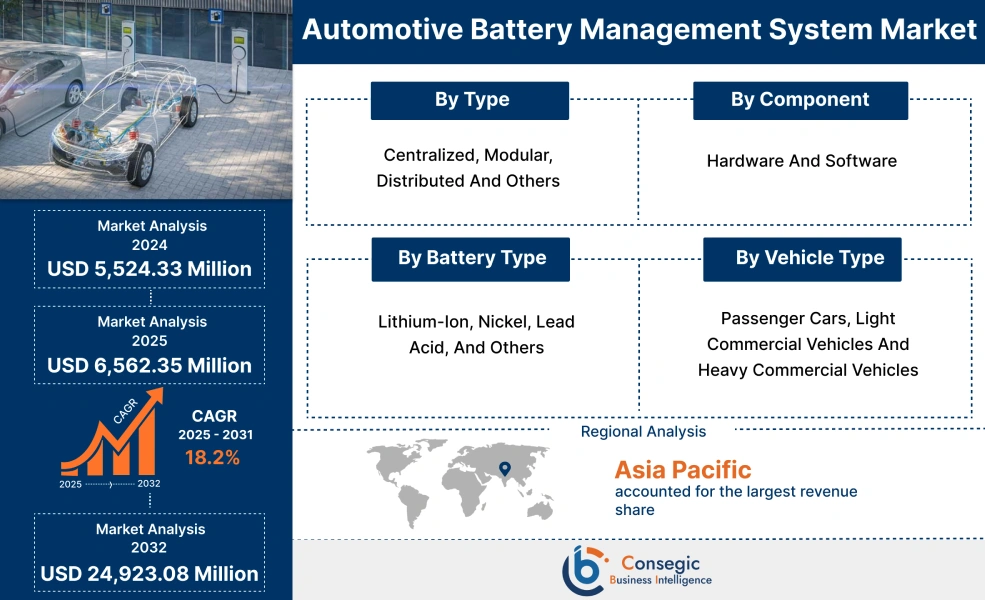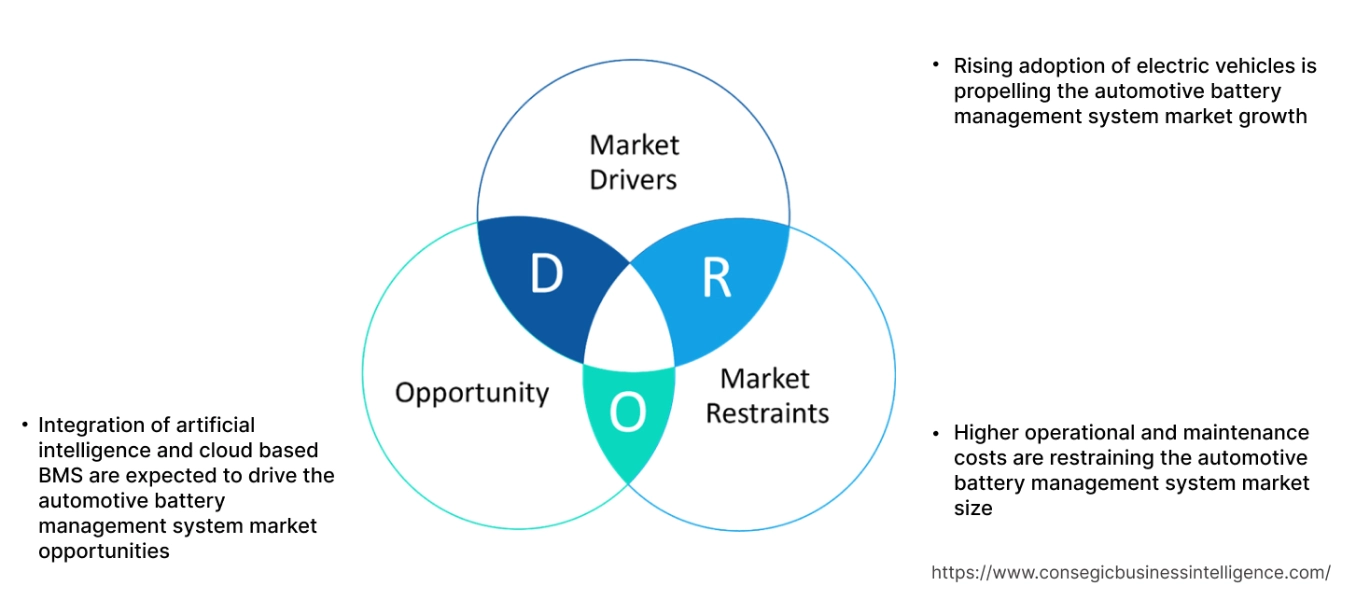Automotive Battery Management System Market Size:
Automotive Battery Management System Market size is estimated to reach over USD 24,923.08 Million by 2032 from a value of USD 5,524.33 Million in 2024 and is projected to grow by USD 6,562.35 Million in 2025, growing at a CAGR of 18.2% from 2025 to 2032.
Automotive Battery Management System Market Scope & Overview:
Automotive battery management system, also known as battery management system (BMS), is an electronic control unit that monitors and manages the performance of rechargeable batteries. In multi cell batteries, battery management system balances the individual cell voltage to ensure safe and efficient operation. Moreover, BMS continuously monitors parameters of the battery as it is a crucial component of battery powered systems. Further, advancements in automatic automobile battery management system include cloud based BMS, wireless BMS, integration of machine learning and artificial intelligence, and others, which are further driving the global automotive battery management system market.
Automotive Battery Management System Market Dynamics - (DRO) :
Key Drivers:
Rising adoption of electric vehicles is propelling the automotive battery management system market growth
The rising adoption of automobile battery management system in electric vehicle is driven by enhanced battery performance and its ability to provide real time data. Moreover, battery management system balances the voltage of individual cells, which further maximizes the battery’s life performance. In electric vehicles, BMS provides accurate readings of the battery’s remaining charge, which allows drivers to make informed decisions about their driving range and charging needs.
- For instance, according to International Energy Agency, the global electric vehicles sales exceeded 17 million units in 2024.
Thus, the increasing adoption of electric vehicles is propelling the automotive battery management system market expansion.
Key Restraints:
Higher operational and maintenance costs are restraining the automotive battery management system market size
High initial investment and maintenance costs associated with complex BMS systems are hindering the market. Implementing advanced battery management systems, including software and hardware installation is expensive for small and medium manufacturers. Moreover, various advanced features like optical sensing, wireless sensing, and active cell balancing are expensive to implement in the system.
Additionally, the data communication between the BMS and other devices is critical and often complex, since different interface systems are used depending on the applications. Therefore, the aforementioned factors are hindering the automotive battery management system market.
Future Opportunities :
Integration of artificial intelligence and cloud based BMS are expected to drive the automotive battery management system market opportunities
In the automotive sector, battery management systems are a crucial part of battery systems which comprises of several components to manage, control, disconnect, and monitor the battery cells of vehicles. Moreover, cloud based BMS offers wide range of benefits like enhanced transparency, reduced operating costs and maximum data security during data transmission. Additionally, integration of AI in BMS improves the battery’s accuracy and provides real time monitoring of battery’s performance.
- For instance, Bosch Mobility offers a cloud-based solution called Battery in the Cloud, for battery management systems. Moreover, this system monitors battery performance and service life in electric vehicles.
Therefore, integration of artificial intelligence and cloud based BMS are projected to boost the automotive battery management system market opportunities during the forecast period.
Automotive Battery Management System Market Segmental Analysis :
By Type:
Based on type, the market is segmented into centralized, modular, distributed and others.
Trends in the type:
- There is a rising trend towards the adoption of centralized BMS, due to its wide range of applications in electric vehicles, which is further driving the market.
- Increasing trend in the adoption of distributed BMS, due to its ability to offer efficient and reliable energy efficiency, is driving the automotive battery management system market growth.
Centralized segment accounted for the largest revenue in the overall automotive battery management system market share in 2024.
- A centralized battery management system utilizes single control unit to manage, control, and monitor the battery pack.
- Moreover, a single controller in centralized battery management system performs several tasks like controlling in charge and discharge rates, monitoring voltage, current and temperature, safeguarding the battery cells, and others.
- Moreover, this type of battery management systems is well suited for compact, and less complex battery systems due to their simplicity.
- Hence, rising advancements associated with centralized battery management systems are driving the market growth.
Distributed segment is anticipated to register a substantial CAGR growth during the forecast period.
- Distributed management systems are decentralized systems where multiple control units manage individual battery modules.
- Moreover, in distributed BMS, each node is responsible for monitoring and managing a subset of battery cells as they communicate with each other to collectively manage the entire battery.
- Distributed battery management offers several benefits such as improved reliability, enhanced scalability, and simplified wiring among others.
- Hence, increasing innovations related to distributed battery management system are projected to drive the automotive battery management system market size during the forecast period.
By Component:
Based on component, the market is segmented into hardware and software.
Trends in the component:
- Increasing technological advancements associated with integration of AI in battery management systems are driving the market demand.
- The rise in adoption of AI sensors in modern vehicles are propelling the market growth.
Hardware segment accounted for the largest revenue in the overall automotive battery management system market share in 2024.
- In an automobile battery management system, hardware components consist of sensors, power electronics, and others.
- Moreover, communication interfaces used in battery management systems enables communication between BMS and other systems like vehicle control unit and charging infrastructure.
- Additionally, sensors in battery management system collects data on voltage, current, temperature and other parameters, which are further used in passenger cars and commercial vehicles.
- Therefore, rising advancements related to hardware components used in battery management systems are driving the market.
Software segment is anticipated to register the fastest CAGR growth during the forecast period.
- In automotive battery management system, software segment includes BMS algorithm, data processing algorithm, user interface, and others.
- Moreover, software offers various control and protection solutions such as protective measures against overcharging, filtering noise, charging and discharging to ensure battery safety, performance, and longevity.
- Additionally, BMS software utilizes technologies like discrete wavelet transform, to filter out noise form sensor data.
- Therefore, according to the analysis, there is a rise in adoption of software-based battery management system, which is further projected to drive the market adoption during the forecast period.
By Battery Type:
Based on battery type, the market is segmented into lithium-ion, nickel, lead acid, and others.
Trends in battery type:
- Increasing use of lithium-ion battery type in vehicles for monitoring, thermal management, and protection against over and under voltage is driving the automotive battery management system market trends.
- Factors like high energy and power density, improved charge and discharge efficiency, and low self-charge are driving the lithium-ion segment.
Lithium-ion segment accounted for the largest revenue in the overall automotive battery management system market in 2024 and is anticipated to register the fastest CAGR growth during the forecast period.
- Lithium-ion batteries are a type of rechargeable battery, which are crucial components in battery management systems, essential for managing and controlling the operation of Li-ion battery pack.
- Moreover, lithium-ion batteries are designed to ensure high precision measurements like fast and efficient balancing, shortened charging time and improved range per charge.
- For instance, Sensata Technologies, a U.S. based company, provides BMS solutions for lithium-ion batteries, which offers high voltage applications, advanced balancing, parallel pack supporting, and others, in turn ensuring safe standards for critical applications.
- Hence, according to the automotive battery management system market analysis, the above factors are projected to boost the market during the forecast period.
By Vehicle Type:
Based on vehicle type, the market is segmented into passenger cars, light commercial vehicles and heavy commercial vehicles.
Trends in vehicle type:
- Rising trend in the utilization of battery management system in passenger cars due to exponential sales of electric vehicles (EVs) is driving the market.
- Increasing demand for battery management system in heavy-duty commercial vehicles, due to advancements in AI integration and BMS systems like cloud-based BMS, is driving the automotive battery management system market trends.
Passenger cars segment accounted for the largest revenue share of 68.52% in the overall system market share in 2024, and it is anticipated to register a significant CAGR growth during the forecast period.
- Battery management systems in passenger cars play a vital role, particularly in EVs for ensuring passenger safety.
- Moreover, BMS prevents the battery from exceeding its safe operating limits, which could lead to electric failures and shocks.
- In passenger cars, BMS provides drivers with information about the battery’s current state of charge, range, and other relevant parameters.
- For instance, according to the Society of Indian Automobile Manufactures, the total sales of passenger cars in India from fiscal year 2024 to 2025 reached 43,01,848 units.
- Therefore, according to the analysis, the rising production of passenger cars and rising adoption of battery management system in passenger cars are driving the market.
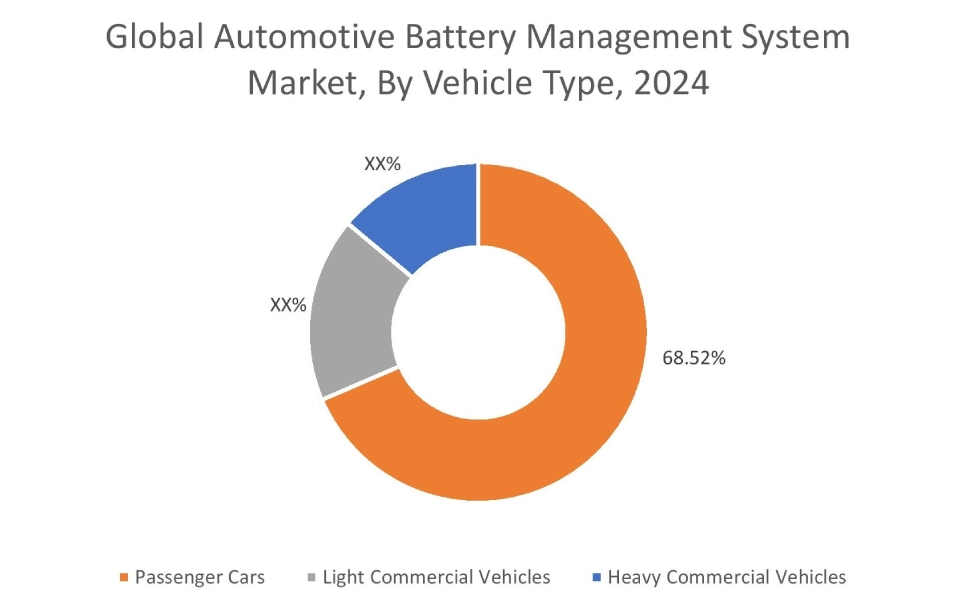
Regional Analysis:
The regions covered are North America, Europe, Asia Pacific, the Middle East and Africa, and Latin America.
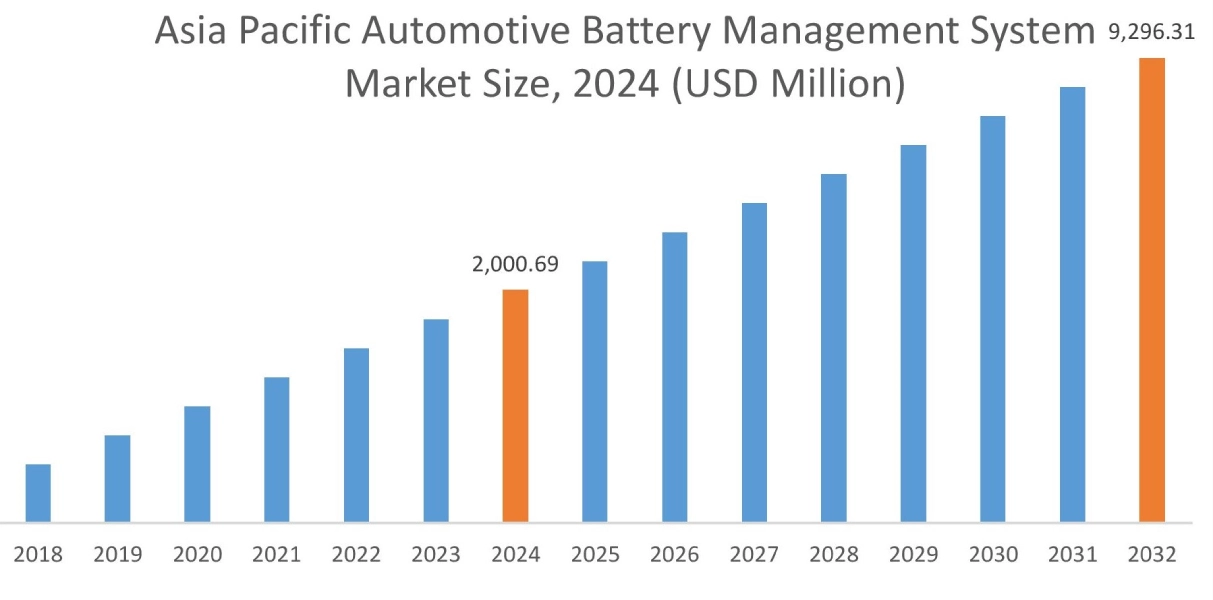
Asia Pacific region was valued at USD 2,000.69 Million in 2024. Moreover, it is projected to grow by USD 2,382.55 Million in 2025 and reach over USD 9,296.31 Million by 2032. Out of this, China accounted for the maximum revenue share of 36.72%. As per automotive battery management system market analysis, the adoption of battery management systems in the Asia-Pacific region is primarily driven increasing adoption of EVs in the region. Additionally, the rising advancements in battery technologies and growing integration in cloud-based BMS are further accelerating the automotive battery management system market expansion.
- For instance, according to the International Energy Agency, the total sales of battery electric vehicles (BEVs) in China reached 5.4 million units in 2023, demonstrating a substantial increase of 22.7% in comparison to 4.4 million units in 2022. The above factors are driving the market in the Asia-Pacific region.
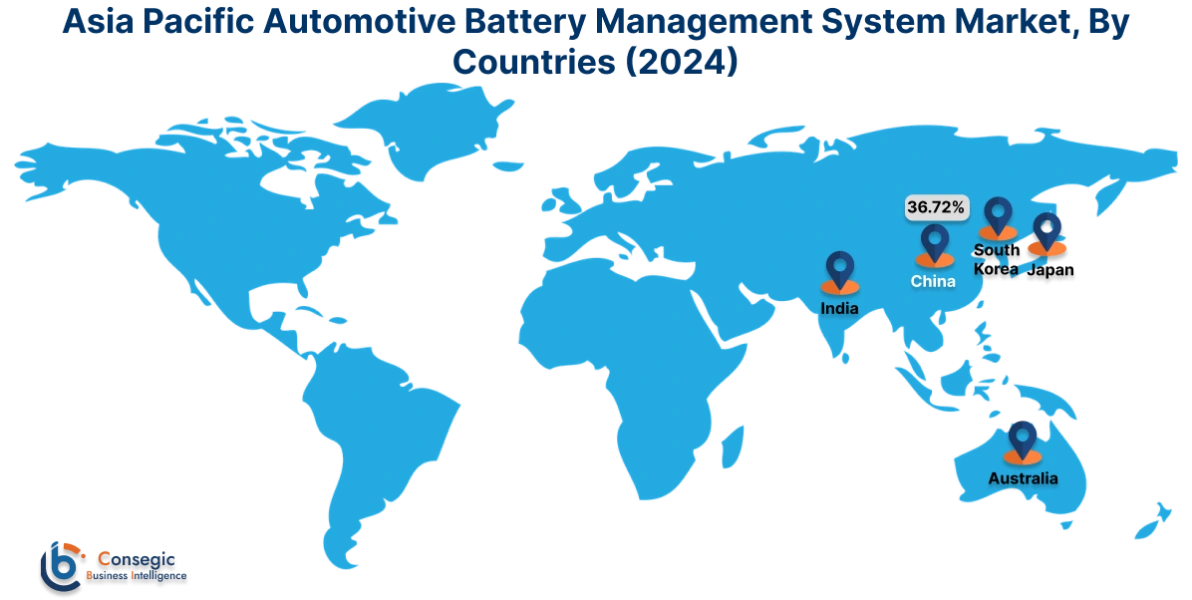
North America is estimated to reach over USD 7,028.31 Million by 2032 from a value of USD 1,567.15 Million in 2024 and is projected to grow by USD 1,860.69 Million in 2025. In North America, the adoption of battery management system is driven by the rising production of automobiles and increasing adoption of electric vehicles (EVs) in the region. Similarly, rising advancements associated with autonomous vehicles are contributing to the automotive battery management system market demand.
- For instance, according to the S. Bureau of Transportation, the United States experienced a significant increase in hybrid plug-in vehicle sales, reaching up to 1,609,035 units in the fiscal year 2024. Thus, battery management systems are used in hybrid plug-in vehicles to ensure safety and monitor the performance of batteries, in turn driving the market in North America.
Additionally, the regional analysis depicts that the rising EV production and growing adoption of automotive battery management systems in passenger cars and heavy commercial vehicles, due to its modular and scalable BMS solutions, is driving the automotive battery management system market demand in Europe. Furthermore, as per the market analysis, the market demand in Latin America, Middle East, and African regions is expected to grow at a considerable rate due to factors such as growing automotive industry, rising investments in electric vehicles, and increasing advancements related to batteries used in EVs.
Top Key Players and Market Share Insights:
The automotive battery management system market is highly competitive with major players providing solutions to the national and international markets. Key players are adopting several strategies in research and development (R&D), product innovation, and end-user launches to hold a strong position in the automotive battery management system industry. Key players in the automotive battery management system industry include-
- Robert Bosch GmbH (Germany)
- Infineon Technologies (Germany)
- AVL (Australia)
- Eberspacher (Germany)
- FICOSA International (Spain)
- Sensata Technologies (U.S.)
- Panasonic Holdings Corporation (Japan)
- Power Tech Systems (France)
- Ethilion (U.S.)
- BMS Powersafe (France)
Recent Industry Developments :
Product Launch:
- In December 2024, Marelli launched its latest battery management system for use in automotive applications. Moreover, the new BMS is integrated with AI and cloud tracking capabilities for optimizing real time estimation of state of charge and state of power of the battery pack.
Automotive Battery Management System Market Report Insights :
| Report Attributes | Report Details |
| Study Timeline | 2019-2032 |
| Market Size in 2032 | USD 24,923.08 Million |
| CAGR (2025-2032) | 18.2% |
| By Type |
|
| By Component |
|
| By Battery Type |
|
| By Vehicle Type |
|
| By Region |
|
| Key Players |
|
| North America | U.S. Canada Mexico |
| Europe | U.K. Germany France Spain Italy Russia Benelux Rest of Europe |
| APAC | China South Korea Japan India Australia ASEAN Rest of Asia-Pacific |
| Middle East and Africa | GCC Turkey South Africa Rest of MEA |
| LATAM | Brazil Argentina Chile Rest of LATAM |
| Report Coverage |
|
Key Questions Answered in the Report
How big is the automotive battery management system market? +
The automotive battery management system market was valued at USD 5,524.33 Million in 2024 and is projected to grow to USD 24,923.08 Million by 2032.
Which is the fastest-growing region in the automotive battery management system market? +
Asia-Pacific is the region experiencing the most rapid growth in the automotive battery management system market.
What specific segmentation details are covered in the automotive battery management systems report? +
The automotive battery management systems report includes specific segmentation details for type, component, battery type, vehicle type, and region.
Who are the major players in the automotive battery management system market? +
The key participants in the automotive battery management system market are Robert Bosch GmbH (Germany), Infineon Technologies (Germany), Sensata Technologies (U.S.), Panasonic Holdings Corporation (Japan), Power Tech Systems (France), Ethilion (U.S.), BMS Powersafe (France), AVL (Australia), Eberspacher (Germany), FICOSA International (Spain) and others.
